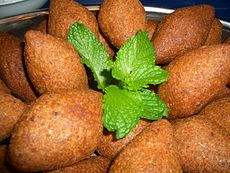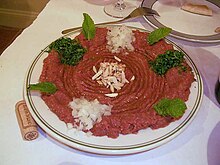Kibbeh
It has been suggested that Kubbeh be merged into this article. (Discuss) Proposed since September 2021. |
 Fried kibbeh raas (nabulsi kibbeh) | |
| Course | Meze |
|---|---|
| Region or state | Middle East |
| Serving temperature | Hot |
| Main ingredients | Finely ground meat, cracked wheat, and Middle Eastern spices |
Kibbeh (/ˈkɪbi/, also kubba and other spellings; Arabic: كبة, romanized: kibba,Turkish: İçli Köfte is a family of dishes based on spiced ground meat, onions, and grain, popular in Middle Eastern cuisine.[1][2][3][4]
In Levantine cuisine, kibbeh is usually made by pounding bulgur wheat together with meat into a fine paste and forming it into balls with toasted pine nuts and spices. It may also be layered and cooked on a tray, deep fried, grilled, or served raw.[5] In Mesopotamian cuisine, versions with rice or farina are found.[6] Some recipes add semolina.[7]
Kibbeh is considered to be a national dish of Syria and especially in Aleppo,[8] and is a popular dish in the Middle East for example in Lebanon, Palestine, Jordan, etc. Versions are found in Cyprus, Egypt, Israel, Iraq, Iran, the Persian Gulf, Armenia, and Turkey.[2] It is also found throughout Latin American countries that received substantial numbers of immigrants from the Levant during the late 19th and early 20th centuries,[9] as well as parts of North America.[10]
Etymology[]
The word is derived from the Classical Arabic kubbah (kibbeh in North Levantine Arabic), which means "ball"[11] or "dome".[12] Various transliterations of the name are used in different countries: in English, kibbe and kibbeh.
Variations[]
Middle East[]
In Levantine cuisine, a variety of dishes made with bulgur (cracked wheat) and minced lamb are called kibbeh. The northern Syrian city of Aleppo (Halab) is famous for having more than 17 different types.[13] These include kibbeh prepared with sumac (kibbe sumāqiyye), yogurt (kibbe labaniyye), quince (kibbe safarjaliyye), lemon juice (kibbe ḥāmḍa), pomegranate sauce, cherry sauce, and other varieties, such as the "disk" kibbeh (kibbe arāṣ), the "plate" kibbeh (kibbe biṣfīḥa or kibbe bṣēniyye) and the raw kibbeh (kibbeh nayyeh).[citation needed]

Kibbeh nayyeh is a raw dish made from a mixture of bulgur, very finely minced lamb or beef similar to steak tartare, and Middle Eastern spices, served on a platter, frequently as part of a meze in Lebanon and Syria, garnished with mint leaves and olive oil, and served with green onions or scallions, green hot peppers, and pita/pocket bread or markouk bread.[1] Because kibbeh nayyeh is raw, it requires high quality meat to prepare and has been seen as a traditional way to honor guests.[2]
Kubba Mosul from Iraq is flat and round like a disc.[2] Kubba halab is an Iraqi version of kibbeh created with a rice crust and named after the largest city in Syria, Aleppo. Kubbat Shorba is an Iraqi and Kurdish version prepared as a stew, commonly made with tomato sauce and spices. It is often served with arak and various salads.[14]
A Syrian soup known as kubbi kishk consists of kubbi "torpedoes" or "footballs" in a yogurt (kishk) and butter broth with stewed cabbage leaves. Another soup, known as kibbeh hamda, consists of a chicken stock with vegetables (usually leeks, celery, turnips and courgettes), lemon juice and garlic, with small kibbeh made with ground rice as dumplings.[15][page needed] In the Syrian Jewish diaspora this is popular both at Pesach and as the pre-fast meal on the day before Yom Kippur.[16]
South America[]

Some regional Jewish cuisines combine kibbeh with elements taken from Latin American cuisine, for example, it is typical of Syrian Jews in Mexico to eat the traditional kibbeh with salsa verde.[17]
On Colombia's Caribbean coast, the most local variations of the dish use ground beef instead of lamb, but the original recipe, or one with mixture of beef and lamb, can be found served by the large Middle Eastern population of the zone. The dish has acquired almost vernacular presence and is frequently served in social occasions at both Arab and non-Arab households. When served as an adopted local dish, it is offered often as a starter along with other regional delicacies, including empanadas, deditos and carimañolas.[18]
Brazilian quibe/kibe, is often stuffed with catupiry or requeijão, a sauce resembling ricotta and cream cheese of Portuguese origin. Most Brazilian kibbeh uses only ground beef, and not other types of meat. Other variations include tahini, carne de soja (texturized soy protein), seitan (Japanese wheat gluten-based meat substitute) or tofu (soybean curd) as stuffing.
See also[]
- List of Middle Eastern dishes
- List of deep fried foods
 Food portal
Food portal
References[]
- ^ Jump up to: a b Marks, Gil (17 November 2010). Encyclopedia of Jewish Food. HMH. ISBN 978-0-544-18631-6 – via Google Books.
- ^ Jump up to: a b c d Perry, Charles (2014). Davidson, Alan (ed.). The Oxford Companion to Food. Oxford: Oxford University Press. pp. 244, 444–445. ISBN 978-0191040726.
- ^ Howell, Sally (2000). Arab Detroit: From Margin to Mainstream. Wayne State University Press. ISBN 9780814328125 – via Google Books.
- ^ Helou, Anissa (4 October 2018). Feast: Food of the Islamic World. Bloomsbury Publishing. ISBN 9781526605566 – via Google Books.
- ^ Perry, Charles PerryCharles (2006), Jaine, Tom (ed.), "kibbeh", The Oxford Companion to Food, Oxford University Press, doi:10.1093/acref/9780192806819.001.0001, ISBN 978-0-19-280681-9, retrieved 2021-02-11
- ^ Annia Ciezadlo (2012). Day of Honey: A Memoir of Food, Love, and War. p. 361. ISBN 978-1-4391-5753-4.
- ^ Marks, Gil (17 November 2010). The Encyclopedia of Jewish Food. ISBN 9780544186316.
- ^ "Top 10 National Dishes -- National Geographic". Travel. 2011-09-13. Retrieved 2020-08-08.
- ^ Brown, Ellen (6 October 2020). Meatballs: The Ultimate Cookbook. ISBN 9781646430147.
- ^ "Kibbe at the Crossroads: A Lebanese Kitchen Story". npr.org. Retrieved 13 November 2017.
- ^ Maan Z. Madina, Arabic-English Dictionary of the Modern Literary Language, 1973
- ^ Marks, Gil (17 November 2010). Encyclopedia of Jewish Food. ISBN 9780544186316.
- ^ "NPR web: Food Lovers Discover The Joys Of Aleppo".
- ^ "An Iraqi-Kurdish-Israeli Dumpling Soup Makes Its Way To America". NPR.
- ^ Claudia Roden, A Book of Middle Eastern Food
- ^ Poopa Dweck (2011). Aromas of Aleppo. Harper Collins. p. 97. ISBN 9780062042644.
- ^ Ayora-Diaz, Steffan Igor (7 February 2019). Taste, Politics, and Identities in Mexican Food. Bloomsbury Publishing. ISBN 978-1-350-06668-7 – via Google Books.
- ^ Cepeda, María Elena. Musical imagiNation : U.S.-Colombian identity and the Latin music boom. ISBN 9780814772904. OCLC 967261642.
- Appetizers
- Arab cuisine
- Armenian cuisine
- Cypriot cuisine
- Egyptian cuisine
- Iranian cuisine
- Iraqi cuisine
- Israeli cuisine
- Jordanian cuisine
- Kurdish cuisine
- Lebanese cuisine
- Levantine cuisine
- Palestinian cuisine
- Syrian cuisine
- Stuffed dishes
- National dishes
- Street food
- Deep fried foods
- Semolina dishes
- Meat dishes
- Bulgur dishes
- Colombian cuisine
- Turkish cuisine
- Brazilian cuisine
- Mizrahi Jewish cuisine
- Wheat dishes
- Fried foods
- Middle Eastern cuisine